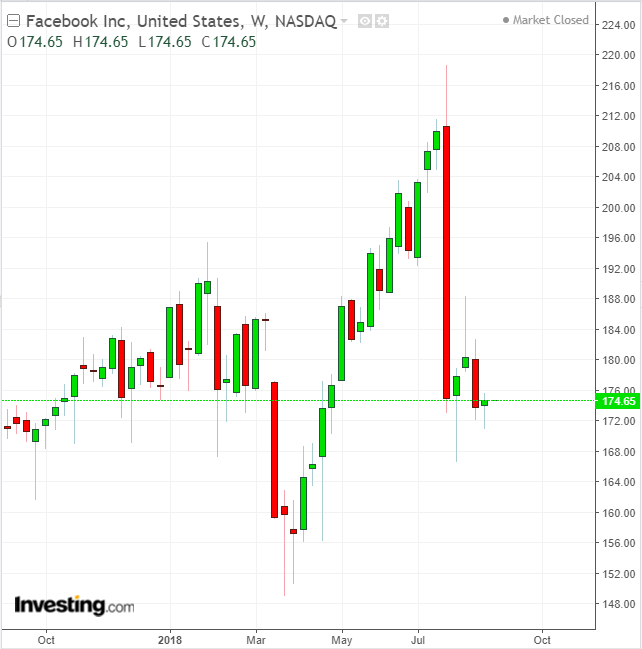The two broadest themes to have emerged from this nearly completed second-quarter earnings season are the divergence of some of the top technology stocks from much of the rest of the market and the strong comeback of the nation’s largest bricks-and-mortar retailers.
Within the tech sector, of the so-called FAANG stocks—Facebook (NASDAQ:FB), Amazon (NASDAQ:AMZN), Apple (NASDAQ:AAPL), Netflix (NASDAQ:NFLX) and Alphabet (NASDAQ:GOOGL)—five technology companies that have led the S&P 500 to record highs and played a major role in the benchmark index's historic bull run could now take a back seat to other stocks. Some of these long-time Wall Street darlings of the new economy showed visible signs of peaking as their growth slowed and the future looked a little uncertain.
Indeed, they have the potential to even derail this longest-ever bull run due to their growing significance within the economy. According to a Bloomberg report, tech companies’ weighting in the U.S. economy has grown significantly since 1999. While tech stocks make up 30% of the value of the S&P 500, they also make up 23% of next year’s expected earnings for the S&P, up from 15% in 1999.
Facebook, the social media behemoth and one of the market’s most valuable companies, plunged more than 20% at the end of July after it missed analysts’ revenue growth forecasts for the first time in three years in the midst of public scandals over privacy and content.

The number of average daily visitors, a key signal for the company’s future growth, also fell short of expectations as Chief Financial Officer David Wehner warned investors that sales growth will continue to slow through the rest of the year.
Netflix, Twitter (NYSE:TWTR) and Snapchat (NYSE:SNAP) also missed analyst expectations on various financial metrics, raising fears of social media contagion that could sputter the market rally. Despite these disappointments, however, it wasn't all bad news for the technology sector.
Other technology giants, including Microsoft (NASDAQ:MSFT), Apple, and Alphabet, continued their upward trajectory after reporting strong sales growth and robust future outlook, providing no signal to investors that their sales and profit growth will slow anytime soon.
Retail Resurgence
While a number of technology companies faced their own challenges amid tightening regulations and data breach scandals, the outlook for the nation's largest retailers brightened on robust job creation and improved consumer confidence.
Buoyed by an unemployment rate near record lows, consumer confidence at a 17-year high and Trump Administration tax cuts, American shoppers loosened their purse strings, helping many retailers to raise their full-year guidance. Walmart (NYSE:WMT), Home Depot (NYSE:HD) and Target (NYSE:TGT) each beat expectations for their Q2 earnings per share and revenue figures.
The biggest surprise was that most of these names reported impressive comparable sales for Q2 versus the same quarter a year ago, suggesting the bricks-and-mortar retail model—despite many recent analyst calls to the contrary—continues to have a future in an era where e-commerce giant Amazon is becoming the preferred method of shopping for many consumers.
Walmart, the world’s largest retailer, posted its best quarterly sales gain in a decade, while Target reported its best results in 13 years. Both the strong earnings and upbeat guidance show that the traditional retail giants are succeeding in their efforts to keep their customers happy by improving the in-store shopping experience while adding more e-commerce purchase and delivery options. The boost across the board also come from enhanced service via every sales channel with better-trained, higher-paid employees.
Bottom Line
Despite some FAANG group misses, the market's uptrend is continuing, breaking new records and generally showing the resilience of the U.S. economy. That said, the visible cracks from FAANG stalwarts Facebook and Netflix losing some of their shine after their Q2 disappointments, have made investors jittery about their future growth prospects.
It's conceivable there could be a potential sector rotation taking shape. Retail and financial shares are coming back, opening up new opportunities for investors who might not see value in continuing to bet on high-flying technology names when their shares are so elevated.
